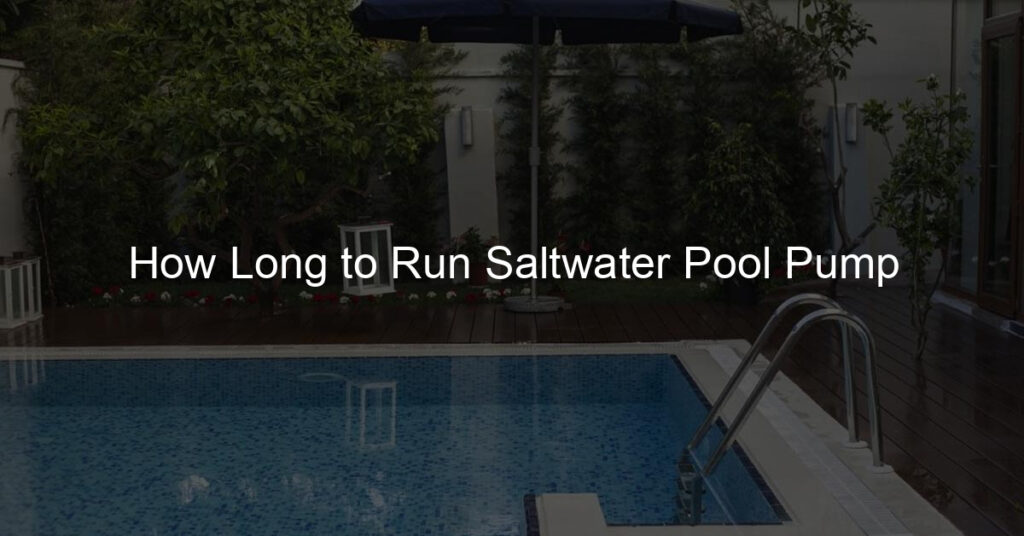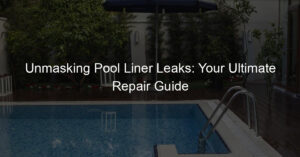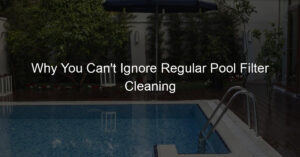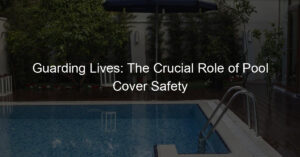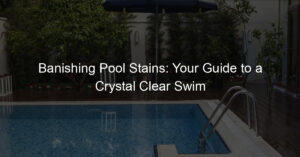Optimal Run Time Guide: How Long to Run Salt Water Pool Pump for Clear Water
How long should you run your saltwater pool pump each day? This is a critical question for maintaining crystal-clear water in your saltwater pool. Whether you’re looking to optimize water clarity, ensure adequate chlorine production, or simply maintain the health of your pool, understanding the right pump schedule is key. Generally, a run time of 8 to 12 hours daily is recommended, but this can vary based on factors like pool size, usage, and weather conditions. In this article, we delve into these variables and offer insights to help you determine “how long to run a saltwater pool pump” for the exact run time needed for your saltwater pool pump.
Key Takeaways
- It’s recommended to run saltwater pool pumps for 8-12 hours daily to ensure clear water by balancing circulation, filtration, and chlorine production while adjusting for factors such as pool size, swimmer load, and weather conditions.
- Chlorine generators require consistent run times to maintain pool sanitation by converting salt into chlorine through electrolysis, and adjustments to chlorine output should be made to prevent algae and ensure clear water.
- Variable speed pumps offer benefits such as energy efficiency, lower operational costs, and reduced wear on the pool system; they should be set to optimal speeds for different times to maximize efficiency and performance.
Determining Your Salt Water Pool Pump Schedule

Consider yourself as a conductor, managing your pool pump’s schedule to achieve the perfect balance in your saltwater pool. It’s like a symphony, with the pool pump, the water, and the various factors playing in harmony for the best performance. The recommended run time for your saltwater pool pump is typically between 8-12 hours each day, ensuring optimal pool filtration and chlorine production.
However, multiple factors can alter the exact run-time, including:
- the pool’s size
- the number of swimmers
- weather conditions
- the pump type used
Think of these factors as the various instruments in your orchestra, each playing a unique role. Understanding these factors will help you master the art of conducting your pool pump schedule, ensuring clear and healthy pool water.
Ideal Daily Operation Hours
Moving on, let’s explore the daily operation rhythm of your pool pump. The recommended run time is approximately 8 hours to ensure proper circulation and filtration of the pool water. This can be extended up to 12 hours a day for optimizing filtration and chlorine production, which is essential for maintaining clear water.
But, what happens if the pump operates for shorter durations? Well, cutting the operation short can lead to the accumulation of debris, algae, and bacteria. It’s like hitting a wrong note in the middle of a beautiful melody – the water might turn cloudy or green due to insufficient circulation and filtration.
Hence, running your saltwater pool pump for the suggested 8-12 hours per day is key to maintaining a harmonious balance in your pool.
Factors Affecting Pump Run Time
Much like how various elements determine a concert’s success – the venue, the audience, and the acoustics – multiple factors influence your pool pump’s run time. The size of your pool is one such factor. Larger pools usually require a longer pump run time to ensure that all the water circulates through the filter system at least once. Additionally, using a pool cover can help maintain water cleanliness, reducing the need for excessive pump usage.
Another critical factor is the bather load. More swimmers mean more contaminants which might necessitate using a supplemental chlorine feeder in conjunction with the saltwater system. Weather conditions, particularly temperature, also influence the optimal duration for running your saltwater pool pump.
Finally, the presence of debris and organic material in the pool can increase the chlorine demand, often requiring longer pump run times. Understanding these factors will help you fine-tune your pump run time for maintaining crystal-clear pool water.
Unveiling the Role of the Chlorine Generator

Think of the chlorine generator as the lead vocalist in our pool maintenance ensemble. The chlorine generator plays a crucial role in maintaining pool sanitation by converting salt into chlorine, effectively killing bacteria and algae in the chlorine pool water. This transformation is nothing short of a magic show, where salt performs a disappearing act and re-emerges as chlorine!
But how does this ‘magic show’, or electrolysis, operate? The salt cell or generator uses dissolved salt in the water to generate chlorine as the saltwater is electrically charged, splitting the salt molecules. It’s a bit of a trial and error process, adjusting the chlorine output based on your pool’s specific needs. This process is an essential act in our pool maintenance show, ensuring a constant and precise level of sanitation.
Chlorine Production Process
The chlorine production process resembles an engaging science experiment conducted in your pool. The chlorine generator electrically charges the saltwater to split the salt molecules and produce chlorine gas. But this process doesn’t operate in isolation. The pump run time plays a crucial role, circulating the water and allowing the salt cell or generator to continuously produce chlorine.
Guaranteeing efficient chlorine production is somewhat similar to baking an ideal loaf of bread. Just like the dough needs the right amount of time in the oven, your saltwater pool pump needs to run for a recommended 8-12 hours per day for efficient chlorine production. Inadequate pump run time can lead to lower chlorine levels, much like undercooked bread falling flat.
Adjusting Chlorine Output
Modifying chlorine output in your saltwater pool equates to fine-tuning a musical instrument. Balancing the chlorine levels is critical to maintaining clear water and preventing the growth of algae and bacteria. This involves modifying the settings of the chlorine generator, just like adjusting the strings of a guitar to get the perfect pitch.
Regularly monitoring and adjusting the chlorine output helps maintain optimal levels. It’s like tuning your guitar before every performance to ensure the best sound. Understanding how to adjust your chlorine output is crucial to orchestrating the perfect pool maintenance routine.
The Consequences of Inadequate Pump Run Time

Just as a poorly tuned instrument can spoil a concert, insufficient pump run time can lead to multiple issues in your saltwater pool. Insufficient run time can lead to algae and bacteria growth due to reduced water filtration and circulation. It can also disrupt the chemical balance of your pool, affecting the consistency of pool chemicals.
Furthermore, inadequate pump run time can impact the performance of your chlorine generator, limiting its ability to generate enough chlorine. Signs of insufficient pump operation include:
- low chlorine levels
- no flow indication on the flow monitor
- stagnant water
- cloudy water
Just like a misstep during a dance performance can lead to a domino effect of errors, inadequate pump run time can cause a cascade of issues in your pool.
Risk of Algae and Bacteria
Like weeds in a neglected garden, algae and bacteria flourish in stagnant water. Insufficient pump run time can lead to:
- Inadequate water circulation
- Impaired filtration
- Inadequate chlorine distribution
- Conditions favorable for the growth of algae and bacteria.
Green, mustard, black, and pink algae are prevalent in saltwater pools, thriving at temperatures above 60°F, particularly in the presence of light and nutrients. Circulating water increases chlorine levels throughout the pool, effectively killing bacteria and algae, thus preventing their growth.
Eliminating algae and bacteria in a regular chlorine pool involves using a chlorine shock, adding liquid chlorine, manual vacuuming, balancing the water chemistry, and maintaining regular pool cleanliness.
Impact on Chemical Balance
Just as an imbalance of ingredients can spoil a dish, your pool can encounter problems due to chemical imbalances caused by insufficient pump run time. This can lead to low chlorine levels, rapid build-up of scale in the cell, and reduced effectiveness of the chlorinator.
Potential effects of a disrupted chemical balance include a decrease in the sanitizer’s effectiveness, calcium deposits’ formation, and pool equipment’s potential corrosion. While insufficient pump run time generally does not directly impact pH levels, it can affect them if it causes aeration due to a spillover or water features running.
An imbalanced free chlorine level due to insufficient pump run time can lead to corrosion or ineffective sanitization.
Maximizing Efficiency with Variable Speed Pumps
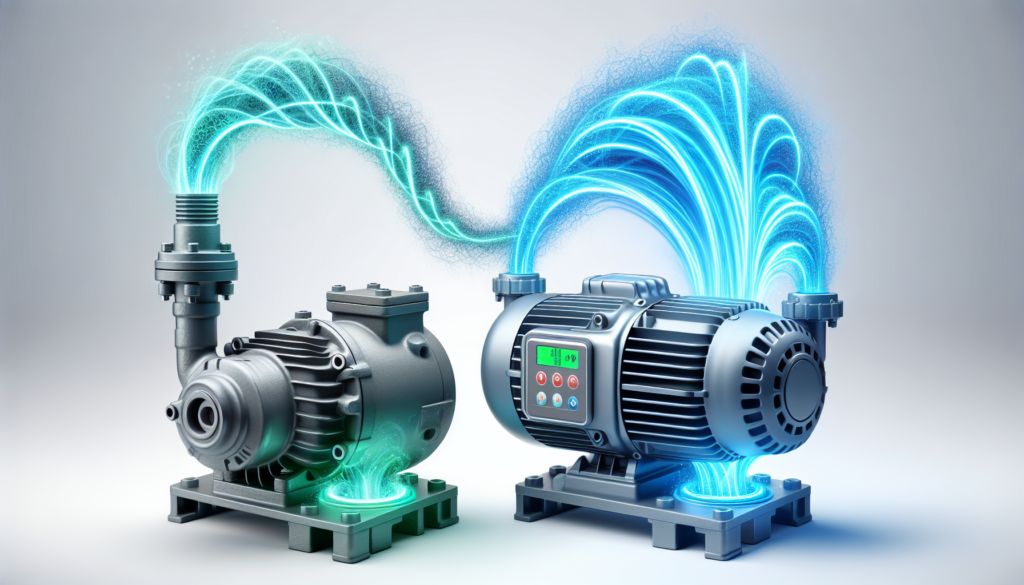
As we progress to the next phase of our swimming pool maintenance guide, let’s introduce a revolutionary element – the variable-speed pool pumps. These pumps are like the eco-friendly electric cars of the pool world – efficient, cost-effective, and environmentally friendly.
Whether it’s reducing wear and tear or putting less stress on the equipment, variable speed pumps play a crucial role in extending the life of a saltwater pool pump. They work like a skilled conductor, programming the pump to slow down below a certain flow rate, controlling water flow through the cell, and leading to regulated chlorine production.
Benefits of Variable Speed Technology
Picture driving a car with enhanced efficiency, less noise, and an elongated lifespan – that’s the experience of having a pool pump with variable speed technology. These pumps offer increased efficiency and reduced electricity usage, resulting in substantial energy cost savings for pool owners.
Variable speed technology offers several benefits for your saltwater pool pump:
- Extends the life of the pump by reducing wear and tear
- Operates at lower speeds, creating a serene environment
- Contributes to sustainability by using less energy
Overall, variable speed technology is a great option for your saltwater pool pump.
Setting Optimal Speeds for Different Times
Just as a maestro syncs the tempo with the rhythm of the music, so does adjusting your variable speed pump align with different pool functions and requirements. Customizing speed settings enhances the pump’s efficiency for each specific function.
The speed of the pump can significantly impact the overall performance and cost-efficiency of a saltwater pool by conserving energy. A schedule that briefly increases the pump speed once or twice a day and then runs at lower RPMs for the remaining time can effectively set optimal speeds.
The Importance of Regular Maintenance
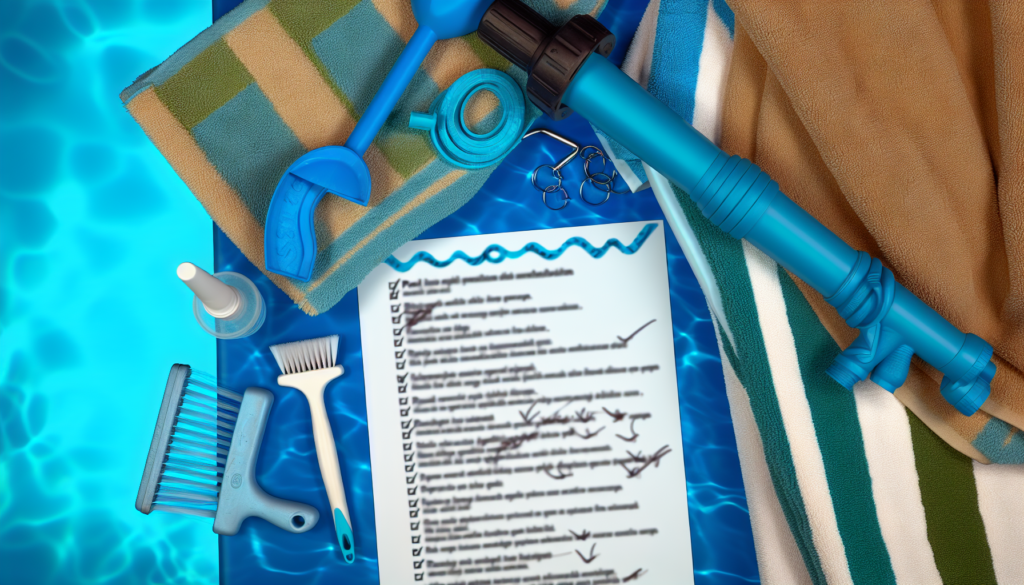
Similar to the need for regular tuning of a musical instrument for peak performance, regular maintenance is vital for optimal pool pump operation. Regular cleaning and inspection of a saltwater pool pump filter maintain proper water flow and ensure optimal pump performance.
Monitoring the salt levels in your saltwater pool is also an integral part of maintaining optimal conditions in your pool. Think of the salt system as the rhythm that keeps the entire band in sync, ensuring that your pool system’s other components work together harmoniously.
Cleaning and Inspecting the Filter Pump
A clean pool filtration system, which includes the pool filter pump, resembles a well-oiled machine, guaranteeing proper water flow and superior pump performance. Regularly cleaning and inspecting your saltwater pool pump filter is crucial to maintaining this performance.
Indications that a filter requires cleaning include a quick return to a high pressure rating after backwashing and water staying cloudy or green despite proper chemical balance. Regular inspection can prevent physical damage, such as cracks, and check for any blockages or debris.
It’s recommended to clean the filter every three to four months, much like how regular tuning keeps a musical instrument in top condition.
Monitoring and Adjusting Salt Levels
Similar to tuning a musical instrument to the correct pitch, maintaining the right salt levels is crucial for sustaining optimal conditions in your saltwater pool. The recommended salt level ranges between 2,700 to 3,400 ppm, with the ideal level being 3,200 ppm.
You can monitor the salt level using tools such as the Aquacheck salt strips, Pool Salt Tester ORAPXI pH and Salt Meter, or a liquid reagent kit. It’s recommended to check the salt levels on a weekly basis, much like a regular instrument tuning schedule. If the salt levels are too high or too low, you can adjust them by removing some of the pool water and refilling with fresh water, or by adding more salt until the optimal level is reached.
Utilizing Timers for Convenience and Precision
Visualize having a personal assistant managing your pool pump’s schedule. That’s what a pool timer can do. Utilizing a pool timer in a saltwater pool can result in energy cost savings, reduced electric bills, and added convenience through the automation of pump cycles.
Pool timers play a crucial role in improving the accuracy of pump schedules by allowing control and adjustment of the operation to align with sunrise and sunset times, ultimately leading to more effective management of energy consumption. It’s like having a metronome to keep your music in time, ensuring your pool pump operates perfectly with your needs.
Selecting the Right Pool Timer
As a musician selects the appropriate instrument, choosing the right pool timer depends on your particular needs and the requirements of your pool system. The market offers various options, including analog, digital, and smart timers.
Digital pool timers offer several advantages, including:
- Lower energy consumption
- Easier maintenance
- Extended lifespan of pool equipment
- Increased safety
And yes, they can manage different speed pumps! A timer for multiple circuits will be necessary if you want individual automatic timing for both high-speed and low-speed.
Preparing for Seasonal Changes
Similar to a musician tuning their melody to match the audience’s mood, tweaking your pool pump schedules and settings to align with seasonal changes is vital for preserving the perfect balance in your pool. As a pool owner, it’s important to know that temperature changes can influence chlorine production in saltwater pools.
During winter, the cold water and low temperatures can potentially cause damage to the salt cell plates and disrupt their regular function. Adjusting your pool pump’s operation to these seasonal changes ensures your pool stays in tune all year round, providing a refreshing swim every time.
Summer Considerations
In the summer months, akin to a musician playing more energetic tunes for a spirited crowd, you might have to modify your pool pump’s operation to cater to the increased number of bathers and higher temperatures. If the pump run time is not increased during the summer, the pool may experience:
- Altered chlorine levels due to sunlight
- A decrease in bacteria elimination
- Higher energy bills
- Potential damage requiring expensive repairs
- A higher likelihood of algae growth
Therefore, increasing the pump’s operation by one hour for every 10°F rise in air temperature helps maintain chlorine levels and prevents the growth of algae and bacteria.
Winter Adjustments
During the winter, much like a musician playing calming tunes for a serene audience, you may need to cut back on your pool pump’s operation and consider measures for freeze protection. This includes various preventative methods to prevent pool equipment and pipes from freezing during winter, ensuring your pool is well-prepared for the colder months.
Adjusting the run time of the pump in winter for optimal performance involves running it at low RPM, around 1,700 RPMs, for several hours each day. This helps to maintain water circulation, filtration, and adequate sanitization even with decreased usage.
Summary
Every component plays a vital role in the grand symphony of pool maintenance. From understanding the optimal run time for your saltwater pool pump to appreciating the role of the chlorine generator, this journey has been about tuning your pool to its best performance. We explored the consequences of inadequate pump run time and how to maximize efficiency with variable speed pumps. We delved into the importance of regular maintenance and timer convenience. And we learned to adjust our pool pump’s performance to the rhythm of the seasons. As you continue your journey as a pool owner, remember, every note matters in creating the perfect melody of a clean and healthy pool!
Frequently Asked Questions
How long do you need to run the pump on the saltwater pool?
You need to run the saltwater pool pump for 12 hours per day to ensure the pool stays free from debris and algae.
Is it better to run the pool pump at night or day?
It’s better to run the pool pump during the day because bacteria thrive in warmer, still water, and running the pump for at least an hour during the day helps prevent this. Additionally, you can save time and money by running your chlorinator for 6 hours at night, which is equivalent to 9 hours during the day.
How does temperature influence chlorine production in a saltwater pool?
Temperature directly impacts chlorine production in saltwater pools, with a 2% increase in conductivity for every 1ºC rise and an approximately 11% production increase for every 10ºF temperature rise.
What benefits do variable speed pumps offer?
Variable speed pumps offer benefits like energy and cost savings and improved water filtration, making them a valuable addition to saltwater pool systems.
What is the recommended frequency for cleaning a saltwater pool pump filter?
It is recommended to clean a saltwater pool pump filter every three to four months, but factors like pool size and usage may affect the frequency.

